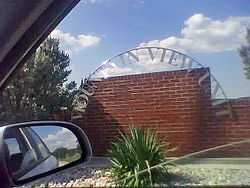Frances Newton

Frances Elaine McLemore Newton (April 12, 1965 – September 14, 2005) was executed by lethal injection in the state of Texas for the April 7, 1987 murder of her husband, Adrian, 23, her son, Alton, 7, and daughter, Farrah, 21 months.
All three victims were shot with a .25 caliber pistol which belonged to a man that Newton had at the time been seeing. Newton claimed that an illegal drug trade/drug dealer killed the three. The Houston police presented evidence that Newton's husband was a drug dealer and was in debt to his supplier. Newton maintained her innocence from her first interrogation in 1987 until her execution in 2005. However, three weeks before the slayings, Newton had purchased life insurance policies on her husband, her daughter, and herself. These were each worth $50,000. She named herself as beneficiary on her husband's and daughter's policies. Newton claimed she forged her husband's signature to prevent him from discovering that money had been set aside to pay the premiums. Newton was also found to have placed a paper bag containing the murder weapon in a relative's home shortly after the murders. Prosecutors cited these facts as the basis for her motive.
Two hours before her first scheduled execution on December 1, 2004, Texas Governor Rick Perry granted a 120-day reprieve to allow more time to test forensic evidence in the case. There were also conflicting reports as to whether a second gun was recovered from the scene; ballistics reports appeared to demonstrate that a gun recovered by law enforcement and allegedly connected to Newton after the offense was the murder weapon. A relative of Newton who was incarcerated shortly after the murders claimed a person he shared a cell with boasted of killing the family. Numerous individuals, including three members of the convicting jury, expressed concern over evidence that was not presented during the trial.
On August 24, 2005, the Texas Court of Criminal Appeals turned down a motion for a stay of execution. It turned down another appeal on September 9 for writ of habeas corpus. It was her fourth application.
The Texas Board of Pardons and Paroles voted 7-0 on September 12 not to recommend that her sentence be commuted to life imprisonment, despite evidence raising doubt about her guilt and a letter from her husband's parents asking that her life be spared. The same day the United States Court of Appeals for the Fifth Circuit refused an appeal of her sentence. Her new attorney, David Dow, also asked Governor Perry for a 30-day stay to prove that Newton was wrongly linked to the murder weapon. The Supreme Court of the United States declined without dissent two appeals on September 13.
Execution

The execution was carried out as scheduled on September 14, 2005 by lethal injection. Frances Newton was the third woman executed in Texas since the resumption of capital punishment in the state in 1982. The first and second were Karla Faye Tucker and Betty Lou Beets. Like Beets before her, Newton made no final statement and did not have a last meal request. Over 30 protesters from the Texas Death Penalty Abolition Movement, the National Black United Front, and the New Black Panther Party had gathered outside the prison. In addition, about 75 people protested the execution outside the governor's mansion in Austin. According to the results of a Public Information Act request submitted by Texas Moratorium Network to the office of Governor Rick Perry, 12,201 people contacted the governor asking him to stop Newton's execution and 10 people contacted him in support of her execution.
During the investigation of Frances Newton, the forensic crime lab in the Houston Police Department was also experiencing intense criticism for the handling of evidence. Michael R. Bromwich, a former U.S. Justice Department official, said the Houston Police Department and city officials "failed to provide the crime lab with adequate resources to meet growing demands" for at least 15 years before the exposure of problems in its DNA division.
See also
- List of women executed in the United States since 1976
- Lists of people executed in Texas
- Capital punishment in the United States
- Capital punishment in Texas
References
- "Texas Woman Faces Execution Despite Questions Regarding Her Guilt". Death Penalty Information Center. 2010.
- "Without Evidence: Executing Frances Newton". Austin Chronicle. September 9, 2005.
- Report from National Coalition to Abolish the Death Penalty
- Report from Texas Moratorium Network
- Offender Information. Texas Department of Criminal Justice. Retrieved on 2007-11-15.
- Last Statement. Texas Department of Criminal Justice. Retrieved on 2007-11-15.
- Frances Elaine Newton. The Clark County Prosecuting Attorney. Retrieved on 2007-11-15.
|